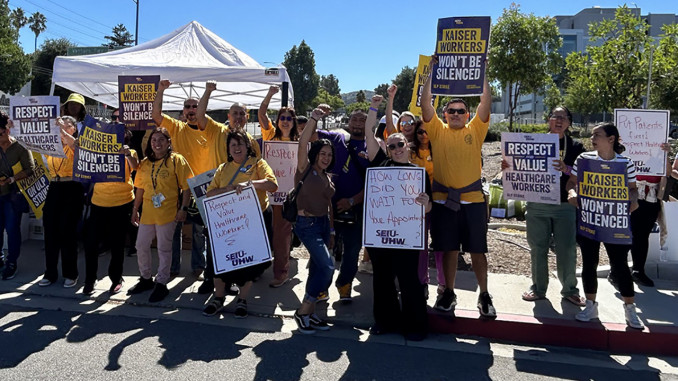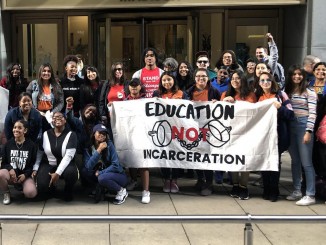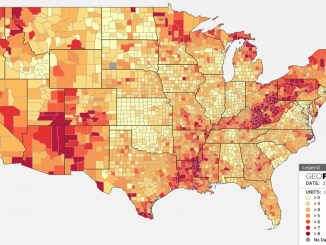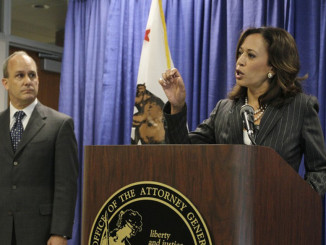
On October 4, 75,000 Kaiser healthcare workers went out on an unfair labor practices strike (ULP). The strike was set to last three days, ending at 6:00 a.m. on Saturday the 7th. Many are considering the strike historic, the largest healthcare workers’ strike in U.S. history. There has been a lot of media coverage of the strike, interviews with Kaiser workers on the picket lines, and with patients expressing sympathy and understanding with why the workers are on strike. Clearly the strike over health care is a subject that many people in the U.S. feel very strongly about given the experience of Covid, and now the day-to-day challenges to accessing health care at Kaiser and other healthcare providers. Health care is a service that links together everyone in the whole society. So, this strike could have the potential of not only mobilizing healthcare workers, but also patients and the general public.
Workers are striking across the country: California, Colorado, Washington, Oregon, Virginia, and Washington DC. The striking workers include: licensed vocational nurses, emergency department and radiology technicians, ultrasound sonographers, respiratory therapists, laboratory and anesthesia technicians, and behavioral health workers, among others. The coalition of unions calling the strike includes SEIU United Healthcare Workers West (SEIU-UHW) and 10 other unions.
Kaiser is a healthcare giant with tentacles reaching across the country. The consortium operates 39 hospitals and more than 700 medical offices, with over 300,000 personnel, including more than 87,000 physicians and nurses. Kaiser’s quality of care is highly rated, doctors receive salaries, rather than being paid on a fee-for-service basis. Kaiser is an integrated health delivery system that organizes and provides all aspects of its members’ health care including preventative care, hospitalization, medical treatments, and pharmacy services.
However, Kaiser has many disputes with its unions over salaries, staffing, and other issues. In addition, the conglomerate has repeatedly faced civil and criminal charges for improper disposal of records and patient dumping. Over the years, Kaiser has developed a bad reputation for limiting doctor visits, long ER wait times, and decreasing service accessibility.
In the last six months, as the Kaiser Coalition of unions engaged in contract negotiations, Kaiser management’s attitude at the bargaining table has been disgraceful. There have been reports of management showing up days late to scheduled bargaining sessions. In addition, Kaiser has paid the media for public advertisements to attack healthcare workers, and has even sent email correspondence to workers to dissuade individuals from striking. Healthcare workers have been gaslit — told that their strike harms patients. Such an accusation utterly disregards the sacrifices healthcare workers made during the pandemic, as well as their daily dedication to provide the best quality care to patients, despite the unreasonable working conditions.
Given Kaiser’s stonewalling at the bargaining table, it is clear why union officials felt they had to call a strike. 75,000 healthcare workers walking off the job across the country does send a powerful message to the boss – without our essential workers, hospitals become dysfunctional and even hazardous. However, Kaiser healthcare workers are up against a behemoth of a company and, given that, it is hard to believe that a three-day fixed ULP strike can put the kind of pressure that is needed on Kaiser. In a three-day strike, with the dates set way in advance, Kaiser has enough money and time to ensure that supervisors and temporary workers could fill some of the jobs of striking workers. This is another sign that Kaiser is not in the least concerned with the quality of patient care.
The Coalition of Kaiser Permanente Unions claims that Kaiser is bargaining in bad faith and has committed numerous Unfair Labor Practices (ULPs). This is correct. However, faced with Kaiser’s stonewalling, it doesn’t seem as if the coalition of unions has done enough to involve the workers in the fight for a fair contract. As the clock ticked closer to October 4 and the start of the ULP strike, healthcare workers appeared to be completely out of the loop on whether the strike would even happen and, if it did, what worker involvement would look like. Workers had very little info on strike demands and the actual state of negotiations. Some wondered if the strike would be called off in the last hour, in line with historical practice. When workers have little knowledge of what is going on behind the scenes, it makes it very difficult for rank-and-file workers to participate, make decisions, and build the organization of the strike.
As a result, In Oakland, for example, many workers stayed home to respect the strike, but far fewer workers were on the picket line. At midday at Kaiser Oakland, one of the main northern California facilities, the number of workers protesting outside the hospital reached a maximum of 300 workers, and the numbers were considerably lower by the afternoon. And little was done in preparation for the strike to appeal to patients or the broader community to come and show active support on the picket lines, even though it is very clear that most people feel a sympathy and support for the healthcare workers’ fight.
It is unclear what will happen after this three-day fixed strike. If a settlement is not reached, there is the threat of the union coalition striking again in November. So much is unknown about what is going on behind the scenes, that the next chapter and outcomes are hard to predict. It seems unlikely, unfortunately, that in this next phase the workers will play a bigger role. Despite all the sacrifices healthcare workers made during the pandemic and continue to make today, there is a strong chance that this top-down approach by the union officials will result in a contract that will not even come close to what the workers want, need, and deserve.




